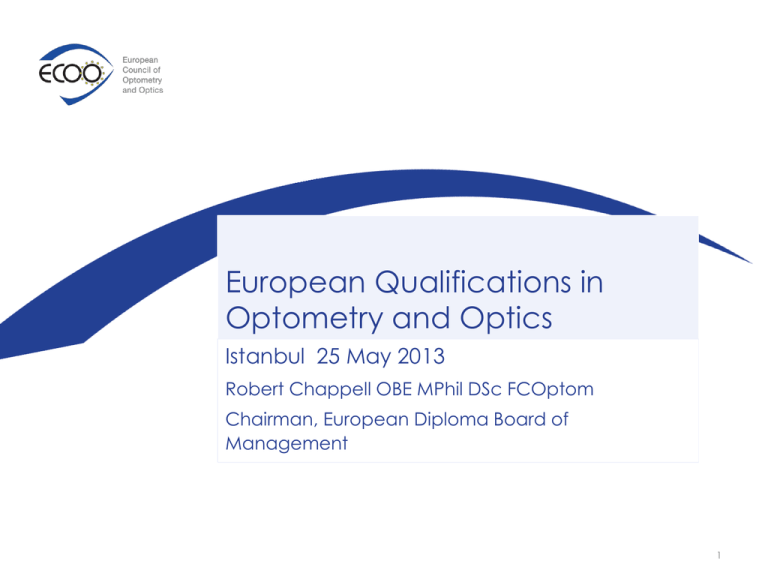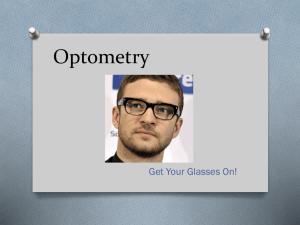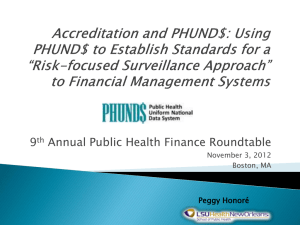European Diploma in Optometry
advertisement

European Qualifications in Optometry and Optics Istanbul 25 May 2013 Robert Chappell OBE MPhil DSc FCOptom Chairman, European Diploma Board of Management 1 Where are we now? • One of the goals of ECOO is to harmonise and develop educational standards and the scope of practice for optometry and optics. • We have a European Diploma in Optometry – set at the highest standard for Europe • This has influenced and developed profession & optometry education • We are developing a qualification in Optics - set at a common entry standard for Europe 2 Optometry and Optics in Europe • Economic conditions vary from country to country • Scope of practice varies enormously • Education at different levels – University – Hand Craft System • No harmonisation 3 A Ladder of Qualification Optometrist Pathology Diagnostic Therapeutics drugs prescribing Optometrist Dispensing Eye Optician examinations Glazing Optical technicians production Optical Support Staff Supply of spectacles Treatment of Ocular disease Refraction Contact Lenses Recognition of ocular anomalies Referral 4 WCO Categories of Optometric Services 1. Optical Technology Services 2. Visual Function Services 3. Ocular Diagnostic Services ------------------------------- a) without drugs dispensing dispensing refraction prescription dispensing refraction prescription screening for eye disease 4. Ocular Therapeutic Services ------------------------------ b) with drugs dispensing refraction prescription diagnosis of eye disease using DPA’s (diagnostics) dispensing refraction prescription diagnosis of eye disease using DPA’s (diagnostics) treatment of eye disease using TPA’s (therapeutics) dispensing refraction prescription diagnosis of eye disease using DPA’s (diagnostics) treatment of eye disease using TPA’s (therapeutics) eye surgery using laser © Feike Grit 2006 5 Scope of Practice of Optics and Optometry Box 1 Turkey Box 2 Belgium France Iceland Italy Box 3 Austria Czech Rep Denmark Germany Spain Switzerland Box 4 Finland Ireland Netherlands Norway Sweden? Box 5 Australia Canada New Zealand Nigeria UK US OPTICIAN REFRACTING OPTICIAN OPTOMETRIST OPTOMETRIST OPTOMETRIST DOCTOR OF OPTOMETRY dispensing dispensing refraction prescription dispensing refraction prescription screening for eye disease dispensing refraction prescription diagnosis of eye disease using DPA’s (diagnostics) dispensing refraction prescription diagnosis of eye disease using DPA’s (diagnostics) treatment of eye disease using TPA’s (therapeutics) © Feike Grit 2010 6 The European Diploma in Optometry • European syllabus • Set at highest entry level of any European Country • Political value – To establish a high standard of optometric practice – Possible harmonisation in the future • Educational Value – To encourage the raising of educational standards – To meet the requirements of the Bologna Declaration 7 The Competency Based ED – 24 Subjects covering the knowledge base and clinical competencies 1. Geometrical Optics 13. Paediatric Optometry 2. Physical Optics 14. Refractive Surgery 3. Visual Optics 15. Anatomy & Histology 4. Visual Perception 16. Neuroscience 5. Optical Appliances 17. General Physiol. & Biochemistry 6. Occupational Optics 18. General Microbiology & Immunity 7. Vision and Aging 19. General Pharmacology 8. Refraction 20. Pathology &General Medical Disorders 9. Low Vision 21. Epidemiology & Biostatistics 10. Ocular Motility and B.V. 22. Ocular Anatomy & Physiology 11. Contact Lenses 23. Ocular Pharmacology 12. Investigative Techniques 24. Abnormal Ocular Conditions 8 The European Diploma in Optometry Structure • Part A Visual Perception and Optical technology – 1. visual perception – 2. optics – 3. optical appliances • Part B Management of Visual Problems – 1. refraction – 2. binocular vision – 3. contact lenses • Part C General Health and Ocular Abnormality – 1. biology – 2. ocular biology – 3. ocular abnormality • Portfolio of Clinical Experience 9 The Benefits • Ahead of its time – Bologna • Promotes educational development • Promotes co-operation between educators • Promotes expansion of scope of practice • Recognised by GOC and Switzerland 10 The Problems • Difficult big bang examination • Lack of preparation of candidates • Low pass rate • No accreditation for prior learning • Small take up limited number of countries • Only three languages • Private examination – limited national recognition • No incentive for many countries to participate 11 The Future • Accreditation of prior learning • Accreditation of national qualifications • Top up examinations • European qualification in optics • Achieving a common European platform • A ladder of qualification 12 Why an ECOO Accreditation scheme? • All European Optometry/Optics programmes can be compared against the same bench mark, the European Diploma • There is a rationale for offering exemptions from parts, or all, the European Diploma Examinations to graduates of appropriate programmes. • National “competent authorities” might find it easier to evaluate the training of applicants from another EU country – this will help to facilitate the free movement of professionals • Training Institutions are encouraged to match their programmes to the competency based European Diploma – this will help to harmonise Optometry and Optics within Europe 13 An Accreditation Scheme for European Optometry and Optics • Emphasis is on learning outcomes. • The competency based European Diploma Syllabus is used as a self assessment document by the training institutions • The institutions indicate where the skills, attitudes, and underpinning knowledge of the competencies are taught and how these are assessed 14 Accreditation and Bench Marking • The Scheme can be used in two ways – Full Accreditation • The self assessment form is analysed and a preliminary opinion on recognition is given • A full visit takes place and a final recommendation is made – Benchmarking • The institution dose not proceed with the visit but uses the preliminary opinion as the basis for developing their course to Diploma standards 15 The Accreditation Scheme 1. The Competency Based ED - 24 Subjects covering the knowledge base and clinical competencies An institution enquires about accreditation for their qualification 2. A copy of the guidelines is sent to them 3. An preliminary meeting is held to discuss the process 4. The self assessment form is completed and analysed 5. Following the analysis further discussions take place 6. A three day visit to the institution takes place 7. A recommendation on the level of accreditation is made to ECOO 16 Accreditation Applicants • Palacky University, Olomouc, Czech Republic – Visited November 2011 • Fachhochschule Nordwestschweiz, Olten, Switzerland – Visited October 2011 • Buskerud University College, Kongsberg, Norway – Visit due March 2012 • Beuth Hochchule, Berlin, Germany – Delayed until first students graduate from new course 17 What a Qualification in Optics should be for ECOO • Developed at a basic level to encompass the reality for opticians • In line with WCO categories • Should complement not conflict with the work of the European Diploma • Should be awarded by accreditation only • So..... 18 Ladder of progression European Diploma in Optometry European Diploma Framework European Qualification in Optics Framework ....? Part B European Qualifications in Optics Part A Part A Accreditation process Part C 19 Proposed Structure of EQO • Includes Part A of the European Diploma • Subject 1: Geometrical Optics • Subject 2: Physical Optics • Subject 3: Visual Optics • Subject 4: Optical appliances • Subject 5: Occupational optics • Extension of workshop practice • A basic understanding of visual optics and refraction • A basic understanding of contact lenses • A basic understanding of ocular anatomy and ocular disorders • A basic understanding of low vision • Communication skills • Business management (Commercial skills/Practice management?) 20 What are the Benefits for Turkey • Compare your syllabus with the European Standard • Educational tool • Political tool • Increase opportunities to increase scope of practice • Greater professional satisfaction • Provide better eye care for the public • Increased freedom of movement and practise throughout Europe 21






